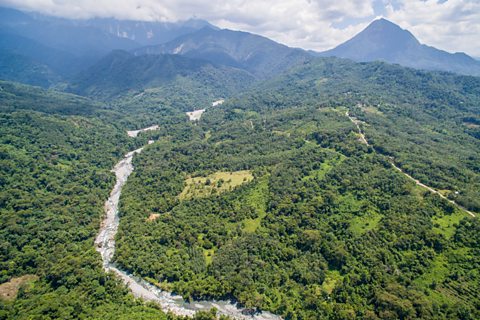Management of tropical rainforests
Tropical rainforests can be managed in the following ways to reduce deforestation.
- Logging and replanting - selective logging of mature trees ensures that the rainforest canopy is preserved. This method allows the forest to recover, because the younger trees gain more space and sunlight to grow. Planned and controlled logging ensures that for every tree logged another is planted.
- Education - promoting the value and benefits of biodiversity associated with tropical rainforests.
- ecotourismTourism which aims to be environmentally friendly. - this encourages sustainableAn activity which does not consume or destroy resources or the environment. tourism that creates jobs for local people whilst ensuring that the money generated is used to protect and conserve the tropical rainforest for future generations to enjoy.
- International agreements - agreements to protect tropical rainforests have been made between different countries through debt-for-nature swapDebt is cancelled if a country agrees to protect its tropical rainforests.. This is when a country, which is owed money by another country, cancels part of the debt if an agreement is made by the debtor country to ensure the conservation of its tropical rainforests.
- Creatingnational parkNational parks are protected areas of land designated by governments to conserve and protect areas of wildlife and beauty. - one of the most effective ways to protect a natural area of land is to create a national park. National parks are intended to preserve an areaās natural beauty and wildlife. Strict laws are set up to prevent people altering national parks and any damage done has to be corrected or large fines can be implemented. Within these, wildlife corridors can be set up to further protect the area and encourage wildlife to flourish between different areas of a rainforest.
Sustainable management ā the Costa Rican rainforest
The Costa Rican government has implemented the following policies to ensure that the tropical rainforest can be conserved and enjoyed by future generations.
- Increasing public awareness of the value of tropical rainforests through education.
- Local communities included and involved in forest conservation projects.
- Encouraging use of alternative timber sources such as rubber trees.
- Selective logging of mature and commercially viable trees over a 40-year cycle to ensure that trees have time to re-establish themselves. This is known as a selective management system.
- Ecotourism promoted and developed in tropical rainforest areas.
- Permanent forest estates have been created by the government where no change of land use is allowed.
- Creation of national parks to protect biodiversity.

The Malaysian rainforest